The Mac
@TheMac
22 February, 04:27
In response Laurie Sunshine to her Publication
Notice: Undefined index: tg1tga_access in /home/admin/www/anonup.com/themes/default/apps/timeline/post.phtml on line 396
The Mac
@TheMac
10 February, 04:07
In response The Mac to his Publication
Notice: Undefined index: tg1tga_access in /home/admin/www/anonup.com/themes/default/apps/timeline/post.phtml on line 396
The Mac
@TheMac
10 February, 04:05
In response The Mac to his Publication
Maia was the wet nurse of the ancient Egyptian pharaoh Tutankhamun in the 14th century BC. Her rock-cut tomb was discovered in the Saqqara necropolis in 1996.
Notice: Undefined index: tg1tga_access in /home/admin/www/anonup.com/themes/default/apps/timeline/post.phtml on line 396
The Mac
@TheMac
10 February, 04:02
In response The Mac to his Publication
"two knights fought to win the hand of a fair maiden"
Notice: Undefined index: tg1tga_access in /home/admin/www/anonup.com/themes/default/apps/timeline/post.phtml on line 396
The Mac
@TheMac
10 February, 03:59
In response The Mac to his Publication
Meritaten, also spelled Merytaten, Meritaton or Meryetaten (Ancient Egyptian: mrii.t-itn)[1] (14th century BC), was an ancient Egyptian royal woman of the Eighteenth Dynasty of Egypt. Her name means "She who is beloved of Aten"; Aten being the sun-deity whom her father, Pharaoh Akhenaten, worshipped
Notice: Undefined index: tg1tga_access in /home/admin/www/anonup.com/themes/default/apps/timeline/post.phtml on line 396
The Mac
@TheMac
10 February, 03:57
In response The Mac to his Publication
Aten also Aton, Atonu, or Itn (Ancient Egyptian: jtn, reconstructed [ˈjaːtin]) was the focus of Atenism, the religious system established in ancient Egypt by the Eighteenth Dynasty pharaoh Akhenaten.
Notice: Undefined index: tg1tga_access in /home/admin/www/anonup.com/themes/default/apps/timeline/post.phtml on line 396
The Mac
@TheMac
10 February, 03:55
In response The Mac to his Publication
Old English, from ecclesiastical Latin, from Greek amēn, from Hebrew 'āmēn ‘truth, certainty’, used adverbially as expression of agreement, and adopted in the Septuagint as a solemn expression of belief or affirmation.
Notice: Undefined index: tg1tga_access in /home/admin/www/anonup.com/themes/default/apps/timeline/post.phtml on line 396
The Mac
@TheMac
10 February, 03:52
In response The Mac to his Publication
Anen or Aanen was an ancient Egyptian nobleman and official of the Eighteenth Dynasty. A priest and administrator, his period of royal service occurred largely during the reign of his brother-in-law, Amenhotep III.
Notice: Undefined index: tg1tga_access in /home/admin/www/anonup.com/themes/default/apps/timeline/post.phtml on line 396
The Mac
@TheMac
10 February, 03:43
In response The Mac to his Publication
AN ENJOYABLENESS
Notice: Undefined index: tg1tga_access in /home/admin/www/anonup.com/themes/default/apps/timeline/post.phtml on line 396
The Mac
@TheMac
10 February, 03:42
In response The Mac to his Publication
enjoyable (adj.)
1640s, "capable of being enjoyed," from enjoy + -able. Meaning "affording pleasure" is from 1744. Related: Enjoyably; enjoyableness
1640s, "capable of being enjoyed," from enjoy + -able. Meaning "affording pleasure" is from 1744. Related: Enjoyably; enjoyableness
Notice: Undefined index: tg1tga_access in /home/admin/www/anonup.com/themes/default/apps/timeline/post.phtml on line 396
The Mac
@TheMac
10 February, 03:41
In response Linda Moore to her Publication
Middle English: from Old French resembler, based on Latin similare (from similis ‘like’
likable (comparative more likable, superlative most likable)
(American spelling) Capable of being liked.
like
/lʌɪk/
verb
past tense: liked; past participle: liked
1.
find agreeable, enjoyable, or satisfactory.
"all his classmates liked him"
likable (comparative more likable, superlative most likable)
(American spelling) Capable of being liked.
like
/lʌɪk/
verb
past tense: liked; past participle: liked
1.
find agreeable, enjoyable, or satisfactory.
"all his classmates liked him"
Notice: Undefined index: tg1tga_access in /home/admin/www/anonup.com/themes/default/apps/timeline/post.phtml on line 396
The Mac
@TheMac
10 February, 03:37
In response Laurie Sunshine to her Publication
❤️👍🏻
Notice: Undefined index: tg1tga_access in /home/admin/www/anonup.com/themes/default/apps/timeline/post.phtml on line 396
The Mac
@TheMac
09 February, 04:18
In response Laurie Sunshine to her Publication
You are so positive and uplifting. Bless your heart. ❤️
Notice: Undefined index: tg1tga_access in /home/admin/www/anonup.com/themes/default/apps/timeline/post.phtml on line 396
The Mac
@TheMac
07 February, 11:06
In response Linda Moore to her Publication
🙏🏻❤️
Notice: Undefined index: tg1tga_access in /home/admin/www/anonup.com/themes/default/apps/timeline/post.phtml on line 396
The Mac
@TheMac
05 February, 03:03
In response Laurie Sunshine to her Publication
❤️👈🏻
Notice: Undefined index: tg1tga_access in /home/admin/www/anonup.com/themes/default/apps/timeline/post.phtml on line 396
The Mac
@TheMac
05 February, 03:02
In response jeanie 333 to her Publication
Positive negative positive negative positive negative and so on.
Notice: Undefined index: tg1tga_access in /home/admin/www/anonup.com/themes/default/apps/timeline/post.phtml on line 396
The Mac
@TheMac
04 February, 07:38
In response The Mac to his Publication
Notice: Undefined index: tg1tga_access in /home/admin/www/anonup.com/themes/default/apps/timeline/post.phtml on line 396
The Mac
@TheMac
04 February, 07:37
In response The Mac to his Publication
Notice: Undefined index: tg1tga_access in /home/admin/www/anonup.com/themes/default/apps/timeline/post.phtml on line 396
The Mac
@TheMac
04 February, 07:30
In response The Mac to his Publication
Animation showing the radiation pattern of a phased array of 15 antenna elements spaced a quarter wavelength apart as the phase difference between adjacent antennas is swept between −120 and 120 degrees. The dark area is the beam or main lobe, while the light lines fanning out around it are sidelobes.
Notice: Undefined index: tg1tga_access in /home/admin/www/anonup.com/themes/default/apps/timeline/post.phtml on line 396
The Mac
@TheMac
04 February, 07:29
In response The Mac to his Publication

Notice: Undefined index: tg1tga_access in /home/admin/www/anonup.com/themes/default/apps/timeline/post.phtml on line 396
The Mac
@TheMac
04 February, 07:27
In response The Mac to his Publication
Starlink is a low Earth orbit satellite constellation that is under construction as of 2021. It is designed to provide broadband internet connectivity to consumers; the user terminals of the system will use phased array antennas
Notice: Undefined index: tg1tga_access in /home/admin/www/anonup.com/themes/default/apps/timeline/post.phtml on line 396
The Mac
@TheMac
04 February, 07:19
In response The Mac to his Publication
5G New Radio (NR) has been designed to fully support Massive MIMO as a native technology from the start. The vastly increased coverage, capacity and user throughput that Massive MIMO provides has quickly made it a natural and essential component of cellular network deployments. 5G Radio Antenna System.16 Feb 2022
Notice: Undefined index: tg1tga_access in /home/admin/www/anonup.com/themes/default/apps/timeline/post.phtml on line 396
The Mac
@TheMac
04 February, 07:17
In response The Mac to his Publication
The shape of the entire mirror is constantly adjusted by a MIMO active optics control system using input from multiple sensors at the focal plane, to compensate for changes in the mirror shape due to thermal expansion, contraction, stresses as it is rotated and distortion of the wavefront due to turbulence in the atmosphere. Complicated systems such as nuclear reactors and human cells are simulated by a computer as large MIMO control systems.
Notice: Undefined index: tg1tga_access in /home/admin/www/anonup.com/themes/default/apps/timeline/post.phtml on line 396
The Mac
@TheMac
04 February, 07:13
In response The Mac to his Publication
Control systems can be divided into different categories depending on the number of inputs and outputs.
Single-input single-output (SISO) – This is the simplest and most common type, in which one output is controlled by one control signal. Examples are the cruise control example above, or an audio system, in which the control input is the input audio signal and the output is the sound waves from the speaker.
Multiple-input multiple-output (MIMO) – These are found in more complicated systems. For example, modern large telescopes such as the Keck and MMT have mirrors composed of many separate segments each controlled by an actuator.
Single-input single-output (SISO) – This is the simplest and most common type, in which one output is controlled by one control signal. Examples are the cruise control example above, or an audio system, in which the control input is the input audio signal and the output is the sound waves from the speaker.
Multiple-input multiple-output (MIMO) – These are found in more complicated systems. For example, modern large telescopes such as the Keck and MMT have mirrors composed of many separate segments each controlled by an actuator.
Notice: Undefined index: tg1tga_access in /home/admin/www/anonup.com/themes/default/apps/timeline/post.phtml on line 396
The Mac
@TheMac
04 February, 07:10
In response The Mac to his Publication
Control theory is a field of mathematics that deals with the control of dynamical systems in engineered processes and machines. The objective is to develop a model or algorithm governing the application of system inputs to drive the system to a desired state, while minimizing any delay, overshoot, or steady-state error and ensuring a level of control stability; often with the aim to achieve a degree of optimality.
Notice: Undefined index: tg1tga_access in /home/admin/www/anonup.com/themes/default/apps/timeline/post.phtml on line 396
The Mac
@TheMac
04 February, 07:08
In response The Mac to his Publication
In audio systems, if a microphone is placed close to a loudspeaker, parasitic oscillations may occur. This is caused by positive feedback, from amplifier's output to loudspeaker to sound waves, and back via the microphone to the amplifier input. See Audio feedback.
Notice: Undefined index: tg1tga_access in /home/admin/www/anonup.com/themes/default/apps/timeline/post.phtml on line 396
The Mac
@TheMac
04 February, 07:06
In response The Mac to his Publication
Parasitic oscillation is undesirable for several reasons. The oscillations may be coupled into other circuits or radiate as radio waves, causing electromagnetic interference (EMI) to other devices. In audio systems, parasitic oscillations can sometimes be heard as annoying sounds in the speakers or earphones. The oscillations waste power and may cause undesirable heating. For example, an audio power amplifier that goes into parasitic oscillation may generate enough power to damage connected speakers. A circuit that is oscillating will not amplify linearly, so desired signals passing through the stage will be distorted. In digital circuits, parasitic oscillations may only occur on particular logic transitions and may result in erratic operation of subsequent stages; for example, a counter stage may see many spurious pulses and count erratically.
Notice: Undefined index: tg1tga_access in /home/admin/www/anonup.com/themes/default/apps/timeline/post.phtml on line 396
The Mac
@TheMac
04 February, 07:05
In response The Mac to his Publication
Parasitic oscillation is an undesirable electronic oscillation (cyclic variation in output voltage or current) in an electronic or digital device. It is often caused by feedback in an amplifying device. The problem occurs notably in RF,[1] audio, and other electronic amplifiers[2] as well as in digital signal processing.[3] It is one of the fundamental issues addressed by control theory.[4][5][6]
Notice: Undefined index: tg1tga_access in /home/admin/www/anonup.com/themes/default/apps/timeline/post.phtml on line 396
The Mac
@TheMac
04 February, 07:03
In response The Mac to his Publication
Electronic oscillation is a repeating cyclical variation in voltage or current in an electrical circuit, resulting in a periodic waveform.[1] The frequency of the oscillation in hertz is the number of times the cycle repeats per second.
The recurrence may be in the form of a varying voltage or a varying current. The waveform may be sinusoidal or some other shape when its magnitude is plotted against time. Electronic oscillation may be intentionally caused, as in devices designed as oscillators, or it may be the result of unintentional positive feedback from the output of an electronic device to its input. The latter appears often in feedback amplifiers (such as operational amplifiers) that do not have sufficient gain or phase margins. In this case, the oscillation often interferes with or compromises the amplifier's intended function, and is known as parasitic oscillation.
The recurrence may be in the form of a varying voltage or a varying current. The waveform may be sinusoidal or some other shape when its magnitude is plotted against time. Electronic oscillation may be intentionally caused, as in devices designed as oscillators, or it may be the result of unintentional positive feedback from the output of an electronic device to its input. The latter appears often in feedback amplifiers (such as operational amplifiers) that do not have sufficient gain or phase margins. In this case, the oscillation often interferes with or compromises the amplifier's intended function, and is known as parasitic oscillation.
Notice: Undefined index: tg1tga_access in /home/admin/www/anonup.com/themes/default/apps/timeline/post.phtml on line 396
The Mac
@TheMac
04 February, 07:00
In response The Mac to his Publication
tACS is similar to tDCS in many aspects but uses oscillating electrical currents at particular frequencies, instead of a direct current, and its main aim is to modulate intrinsic oscillatory activity in the brain (Fig. 7).
Notice: Undefined index: tg1tga_access in /home/admin/www/anonup.com/themes/default/apps/timeline/post.phtml on line 396









